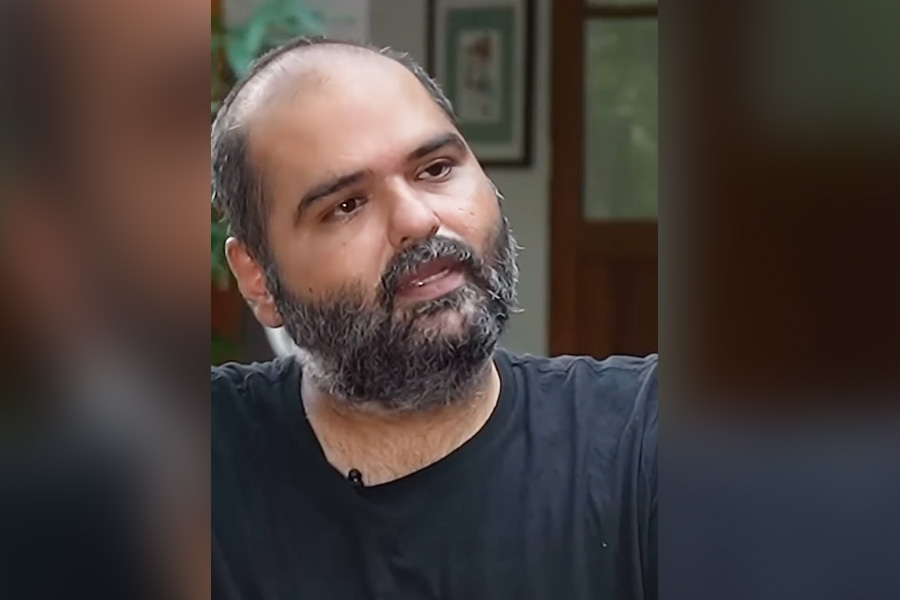 |
| A painting of Mahabali commissioned by Marthanda Varma of the Travancore royal family |
How would a benevolent, just and deeply devout king who legend says built a world free of vices have looked like: short, pot-bellied and cartoon-like with a handlebar moustache, or refined and handsome with an expression of nobility?
That’s the question spicing up the finger-licking feast in Kerala this Onam season — the Malayali equivalent of Durga Puja in Bengal when the southern state immerses itself in 10 days of festivities. Thiruvonam, the most important day in the Onam calendar, falls on Monday.
Some Malayalis are debating the looks of Mahabali aka Maveli, the Asura (demon) king who folklore says ruled the earth thousands of years ago and whose annual “visit” to his subjects is celebrated through Onam.
Ardent Mahabali fans are aghast at the portrayal of their beloved king as a podgy figure in government and commercial ads during the Onam season, as well as in literature on the festival, paintings and TV pictures. They feel the popular depiction resembles a jester rather than an idealist king whose praise they have grown up listening to.
| now showing |
 |
 |
| The way Mahabali is depicted now in commercials |
Leading the “protesters” is the head of the family that once ruled the erstwhile Travancore, Uthradom Tirunal Marthanda Varma, who made headlines recently as custodian of the Sree Padmanabha Swamy temple when its secret vaults revealed riches worth billions. Varma would have been the Maharaja of the most powerful princely state in Kerala had the title and privileges not been abolished.
“This is commercial caricature. Mahabali has been portrayed in a poor light but people seem least bothered,” an anguished Varma told The Telegraph.
The 91-year-old royal, whose brother was the last king of Travancore, said he had never seen any image of Mahabali in his childhood and could not pin the origin of the popular version down to any specific date.
“It’s only after Independence that this pot-bellied figure came into being. The idea of a caricature is to reflect the subject’s weaknesses without hurting him or her, but in Mahabali’s case, it’s being done deliberately to poke fun at him,” he said.
Varma regretted that the “comical” representation of the Onam mascot went hand in hand with the growing commercialisation of the festival.
“In the past, it was an occasion for families to come together, worship together and prepare the feast. Now the happiness is restricted to shopping.”
G. Sukumaran Nair, general secretary of the Nair Service Society, which represents the Hindu Nair community, agrees.
“Onam should be seen as an opportunity to represent Mahabali’s administrative skills and sacrificial nature. Hasn’t the Malayali of late been celebrating festivals without knowing their essence?” Nair wrote in the latest issue of the outfit’s mouthpiece, Service.
“The representation of Mahabali, a role model for rulers, is an example. During Onam, we show him as a representative of the consumerist culture. The king is mockingly presented with features that are attributed to lazybones, like a pot belly and a handlebar moustache.”
Nair wondered whether the caricature reflected “a traditional artistic bias towards showing Asuras with shoddy features”.
 |
| An entry to a ‘Draw your Maveli’ contest organised by the Malayala Manorama newspaper which asked its readers if Mahabali was indeed portly. From more than 1,000 sketches, the newspaper published six that veered away from the traditional depictions |
Disgusted by the popular portrayal, Varma had two years ago got an artist to render an image of the legendary king based on his personal beliefs. The “cosmetic makeover” by the artist, Krishnan Nair, gave Mahabali a narrower waistline and an “aristocratic” moustache in place of the handlebar.
K.K. Warrier, a mural painter from central Kerala, too is miffed by the “comical portrayal of the great soul” and referred to ancient scriptures to explain why it needed correction.
“The rules of drawing are basically laid down in the text Vishnu Dharmothara Purana in a chapter titled Chitrasootram. According to this, kings must be portrayed like gods,” said Warrier, who too has come up with his version of Mahabali.
Although the images of a squat Mahabali have been around for decades, it was Varma’s public objections two years ago that kicked off the protests, which are now showing signs of assuming political overtones with the Vishwa Hindu Parishad wading in.
V. Mohanan, the outfit’s Kerala secretary, said: “In plays and movies and even school texts, the noble king is depicted as a funny character. It is an insult to his greatness. Since this is also linked to religious (scriptural) beliefs, it is high time this is rectified.”
Filmmaker Adoor Gopalakrishnan, however, had a different take on the subject.
“I cannot speak authoritatively on the matter as I have not gone into it in depth. But I believe the king’s popular stocky figure must have had to do with the traditional imagery of a Malayali landlord or aristocrat, who would ordinarily be an idler and enjoy the fruits of others’ labour. Hence the pot belly.”
King whom gods tricked
 |
The Puranas say the Asura king Mahabali was the grandson of Prahlad, son of king
Hiranyakashipu who was killed by Vishnu’s fourth avatar, Narasimha.
The gods suspected Mahabali, an efficient and righteous ruler, of eyeing their domain and sought Vishnu’s help to checkmate him. Vishnu took the form of a midget Brahmin boy, Vamana (in picture), and asked
Mahabali to donate him as much land as he could cover in three (dwarf) paces.
Mahabali allowed the request, upon which Vamana enlarged his body to gigantic dimensions and covered the earth and heaven in his first two paces. With nothing left to cover by the third pace, Mahabali asked Vamana to place his foot on his head. Vamana did, pushing Mahabali to Paataal (the netherworld).
On Mahabali’s request, though, Vishnu allowed him to return every year to visit his subjects. This visit is commemorated as the 10-day Onam festival in Kerala.
Few have captured the decline and decay of the erstwhile feudal class, the Nairs, as Adoor did in his acclaimed movie, Elippathayam (The Rat Trap).
Adoor also disagreed with the protesters, arguing the image had become too “entrenched in the minds of the people” to be altered now.
Although Onam is rooted in Hindu motifs, it has acquired a secular profile because few can insulate themselves from the infectious mood that pervades Kerala when the season sets in.
Besides, the belief that Mahabali ran a Utopia-like state has prompted some to describe Onam as the world’s oldest “socialist festival” —– a label that strikes a chord in a state that usually alternates between governments led by the communists and the Congress every five years.
Such interpretations also make Onam more digestible to communists, just as community participation allows Durga Puja to transcend barriers in Bengal.
B.S. Praveen Kumar, chief manager (public relations and events) with Asianet Television, sought to justify TV channels’ use of the pot-bellied images of Mahabali.
“That’s the image with which people are familiar. But during one of our shows, Njan Kodeeswaran (the Malayalam version of Kaun Banega Crorepati), we did highlight a painting of Mahabali that had been passed on to us by the royal palace (the painting by Krishnan Nair that Varma commissioned) and conveyed its significance to our viewers.”
Superstar Suresh Gopi, who hosts the show Njan Kodeeswaran and has the looks that can match the Varma-approved version of Mahabali, told The Telegraph that he subscribed to Varma’s views.
“Everything is a matter of our belief. Why should we depict Mahabali as a comic figure when his life story is full of goodness? It is my belief that he must have been a fit and trim figure. The new Mahabali should be promoted with full vigour,” he said.
Another channel, Amrita TV, has opted for the slimmer version. “Mahabali was not a comic character, and our decision to portray him as trim and in shape was a conscious one,” said Hari S. Kartha, the executive director of the channel that is run by the Mata Amritanandamayi Math.
Onam is a harvest festival when families wear new clothes, make floral arrangements at home and invite relatives and friends to feasts. M.G.S. Narayanan, historian and former head of the Indian Council for Historical Research, traced its history for this newspaper.
Narayanan said none of the ancient texts that mention Mahabali makes any reference to Kerala, so any suggestion that he ruled over the state has to be treated as fiction.
“There are five or six Puranas that cite the story of Mahabali and how he was banished from earth by Vamana, the avatar of Vishnu. But what records like the poems of the Tamil Alwars, who were Vishnu devotees, and copper plates from some central Kerala temples suggest is that at least till the 11th century or so, the hero of the festival was Vamana,” he said.
“But by the 16th century, the festival, which had till then been confined to temples, began to be celebrated at homes as well and Mahabali gained prominence over Vamana. The Mahabali imagery can be attributed to this democratisation of the festival.”











